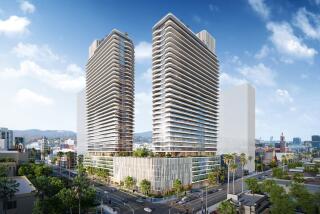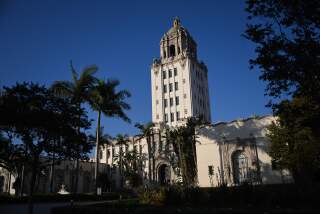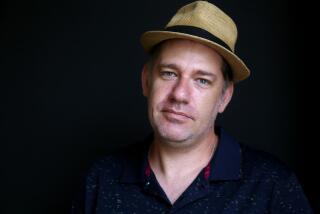Garcetti’s Hollywood script
- Share via
Chris Robbins could be a poster child for mayoral candidate Eric Garcetti’s vision for Los Angeles.
Each morning, Robbins straps on a backpack, cues up his iPod and sets out on a short walk to the subway, which whisks him to his downtown public relations job. He and his wife share one car. On the weekends, they like to stay local, savoring their neighborhood’s array of new restaurants and bars.
Over 12 years as Hollywood’s councilman, Garcetti has emerged as a leading champion of “smart growth,” which aims to entice residents like Robbins out of cars by densely concentrating new development along transit lines.
The councilman has helped muscle through tens of millions of dollars in taxpayer subsidies for construction projects and has backed exemptions permitting developers to build bigger than zoning laws allow. The result has been an explosion of development on the streets surrounding the Hollywood Walk of Fame, including nearly 3,500 residential units built or under construction.
Hollywood is “a template for a new Los Angeles,” Garcetti says, “a blueprint for a city where you can live near where you work, near where you play ... where the hours you don’t have to spend in your car, you can spend with your family.”
But the high-density growth also has brought worries about rising rents and traffic-choked streets.
The building boom has generated dozens of lawsuits from community activists who accuse Garcetti and the city of giving away too much to developers. Garcetti’s opponent, Wendy Greuel, has warned L.A. could become “a new Manhattan” under a Garcetti administration.
She also criticizes his role in helping steer a $30-million taxpayer loan to a developer whose pledge to bring a long-running Cirque du Soleil production to the heart of Hollywood collapsed after just 16 months. The show’s abrupt closing last year took with it the promise of 850 jobs and hundreds of millions of dollars in economic activity.
The city loan is secured and not at risk, officials say, and Garcetti insists the renovation of the Dolby Theatre was worth the investment. But Greuel complains that the public money “could have been used to revitalize parts of South Los Angeles, or neighborhoods in the Valley.”
That theme could resonate with voters beyond Hollywood. A USC Price/Los Angeles Times poll last month found 38.4% of likely voters viewed Garcetti as caring more about big business and developers than the city as a whole, compared with 30.6% who viewed Greuel that way.
Garcetti says he’s no density hawk pushing for New York-style skyscrapers across the city: “What you do in Granada Hills is not the same thing you do in Hollywood.” But he said that building more in select areas, such as along Wilshire Boulevard and in parts of South L.A., makes sense.
So does leveraging public money to spur development, he says. And an isolated bad outcome like the closure of the Cirque du Soleil show, he argues, shouldn’t overshadow dozens of success stories and the positive potential of the Hollywood model.
On the campaign trail, Garcetti regularly draws flattering comparisons between Hollywood now and what it used to be, “when you saw street prostitution, drug dealers and empty storefronts.”
Leron Gubler, the head of the Hollywood Chamber of Commerce, credits Garcetti with setting a business-friendly tone for the area and being able to forge consensus between opposing groups. “People who are going to spend hundreds of millions of dollars aren’t going to invest unless they think they can work with the councilman,” said Gubler, whose group has endorsed Garcetti.
Hollywood’s revitalization was underway long before Garcetti took office. Former Councilwoman Jackie Goldberg helped deliver the catalytic Hollywood & Highland shopping complex, which opened in 2001 with $90 million in city assistance.
Garcetti’s involvement was seen as pivotal in other projects, including the $500-million W Hotel complex at the fabled corner of Hollywood and Vine. In 2006, the project was in jeopardy. Shopkeeper Bob Blue was fighting the redevelopment agency’s use of eminent domain to seize his family business. According to Gubler and Helmi Hisserich, who worked for the agency, the project was close to losing its funding when Garcetti and his staff stepped in.
“He said, ‘I want you to talk. I want you to work out a deal,’” Hisserich said. Blue and the agency ultimately agreed the project could be built around Blue’s luggage business.
That sort of engagement wins Garcetti accolades in the business community. But taxpayer watchdogs have accused him of failing to guard community interests.
In 2006, developer Hal Katersky proposed an eight-story, $57-million office building at Vine Street and Selma Avenue.
Redevelopment officials said office space was needed badly in a neighborhood planners feared was being overbuilt with housing. They agreed to buy the land from Katersky for $5.45 million and sell it back to him and his partners at a Chicago-based investment company at a discount.
But an appraisal by the redevelopment agency put the property’s value at $1 million less than the city paid for it. In a report, redevelopment officials said key documentation from the project had gone “missing,” obscuring the reasons why a higher appraisal was used in the purchase. Later, the city agreed to sell the property back to Katersky’s group for just $825,000.
Despite questions about the appraisal and transaction, Garcetti urged the council to approve the deal.
“Let’s not hold the project and the community hostage for a mistake made early on,” he said at the time. Garcetti defended the initiative, citing the need for office space.
The project now is on hold. Katersky sold his stake in the project for a price he declined to provide. The company now in control has struggled to find financing, according to redevelopment officials. To help revive the project, officials recently removed a requirement that it be geared to attracting entertainment industry tenants.
Garcetti also has backed projects that required special exemptions because they were bigger than what was allowed under existing zoning restrictions. A 22-story condominium tower now under construction on Sunset Boulevard was granted more than a dozen zoning exemptions, including special entitlements that allow the developer to build five times taller than the 45-foot height limit.
Garcetti also has urged developers with modest proposals to think bigger and include more retail and housing. “It was always very clear that he was tussling with the applicants to reshape the projects,” said Jane Usher, a former president of the city Planning Commission.
In one case, Walgreens wanted a conventional one-story drugstore at Sunset and Western, with a large parking lot in front. Because it was near a Red Line subway stop, the councilman persuaded the builder to add several stories of low-income apartments to the project.
Critics say the city has no proof such “smart growth” will get vehicles off the street. Gains in ridership on the Hollywood subway line over the last decade have been matched by rail lines in other parts of the city.
“There is no data to support this dang fantasy that if you build skyscrapers filled with multimillion-dollar condos, but with inadequate parking, that that will translate into people giving up their cars,” said attorney Robert P. Silverstein, who has sued to stop various projects in Hollywood.
Some housing advocates worry that flashy new developments are displacing poor residents.
“It essentially puts a bull’s-eye on the back of low-income tenants,” said Larry Gross of the Coalition for Fair Housing. “Our fear is that all of this is going to be luxury high-rise units for executives and yuppies and stuff.”
That problem is not unique to Hollywood, Gross said. When Greuel was on the City Council, the city housing department ranked her San Fernando Valley district second in the number of rent-controlled units lost as apartments were converted into condominiums, he said.
Garcetti says increasing affordable housing is one of his priorities. Housing department statistics show that from 2000 to 2011 there was a small net gain of affordable apartments in Hollywood, including the addition of homeless housing and a residential complex for elderly lesbians and gays. He wrote legislation that required landlords to build new affordable housing if they demolished rent-controlled units.
But the big ambitions for Hollywood backed by Garcetti have prompted more residents like Rosemary DeMonte to join community groups opposed to more density.
“We’re not against development, but we’re for sensitive, reasonable development,” DeMonte said. “I don’t want it to become LA Live.”
--
More to Read
Sign up for Essential California
The most important California stories and recommendations in your inbox every morning.
You may occasionally receive promotional content from the Los Angeles Times.











